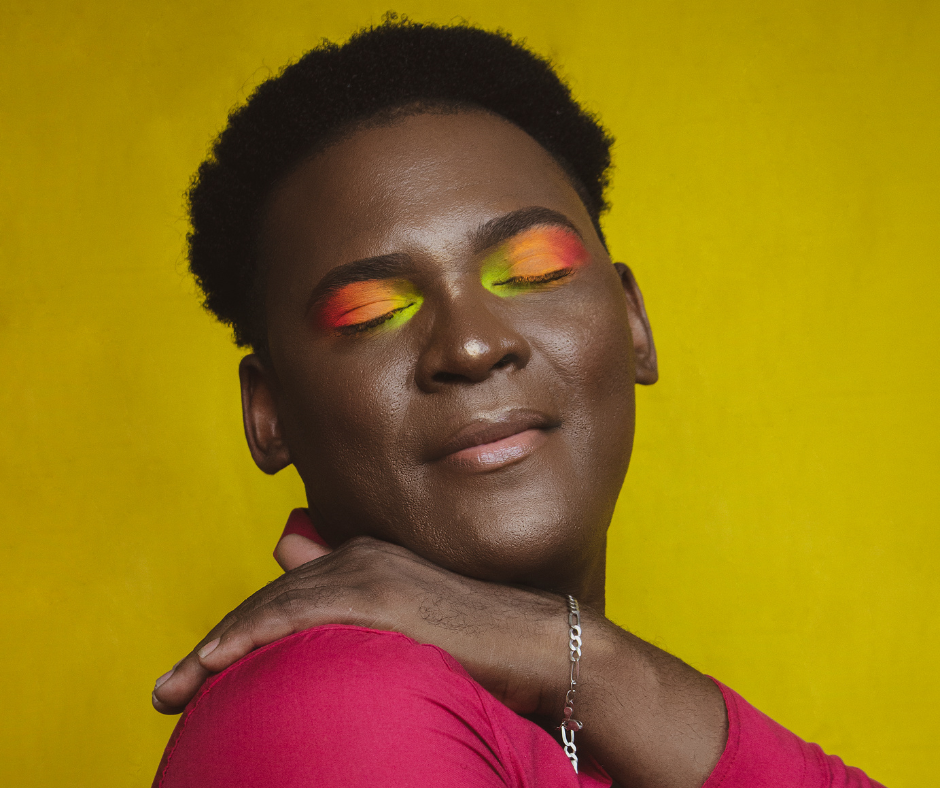“When My Body Doesn’t Feel Like Mine”: Grounding Through Gender Dysphoria
There are days when your reflection doesn’t look like you — not in a simple, bad-hair-day kind of way, but in a deeper, aching way that pulls you out of your body entirely.
It can feel like living behind glass, like your voice doesn’t belong to you, or your skin is too tight. This is the lived reality of gender dysphoria — a disconnect between the internal self and the external form, often intensified by societal expectations, misgendering, or body-based triggers.
This isn’t vanity. This isn’t insecurity. It’s a nervous system response — a deeply embodied conflict between identity, perception, and safety.
Let’s explore how dysphoria shows up in the mind and body, and how to find gentle, sustainable ways to reconnect with yourself through it.

The Nervous System Side of Gender Dysphoria
When your body feels “wrong,” it’s not just psychological — your autonomic nervous system is involved. Dysphoria can activate the same survival circuits as trauma. The brain senses a mismatch between your internal identity and your physical cues, which can trigger fight, flight, freeze, or fawn reactions.
For example:
- A mirror glance may spark fight (“I hate how I look”).
- A voice recording may trigger flight (wanting to avoid hearing yourself).
- Body touch may cause freeze (feeling numb, distant, or panicky).
- Or constant people-pleasing may reflect fawn — a way to manage social discomfort and be “accepted” despite the dysphoria.
This means healing isn’t just about “thinking positively” — it’s about calming your body’s threat response when dysphoria arises.
Body Dysphoria vs. Body Awareness
People often confuse dysphoria with body image issues, but they’re not the same.
Body image dissatisfaction says, “I don’t like how I look.”
Gender dysphoria says, “This doesn’t feel like me.”
The distinction matters because it changes how you approach healing.
You don’t have to force yourself to “like” your body right now. The work is to rebuild a safe relationship with your body — one based on curiosity, consent, and compassion rather than control or avoidance.

The Role of Dissociation
Many people with chronic dysphoria experience dissociation — zoning out, spacing out, or feeling detached from sensations. This isn’t weakness; it’s your body’s way of protecting you from constant discomfort.
Learning to gently “re-enter” your body can take time. You may need structured grounding practices that remind your nervous system: This is safe enough to feel.
15 Therapist-Approved Practices for Grounding Through Gender Dysphoria
These aren’t quick fixes — they’re small ways to help your body and mind reconnect, gently and safely.

1. Name What’s Happening — Without Judgment
One of the hardest parts of dysphoria is the shame spiral that often follows. Instead of judging the feeling (“Why can’t I just accept myself?”), try naming it: “I’m feeling dysphoria right now.” This small linguistic shift moves your brain out of the amygdala (fear center) and into the prefrontal cortex, which helps with regulation and perspective. It turns panic into observation — and that’s where healing begins.
- Say aloud: “This is dysphoria. It makes sense I feel this.”
- Write what you feel in your body (tight chest, heat, nausea, pressure).
- End with compassion: “This feeling is valid, but it won’t last forever.”
2. Create a Sensory Grounding Routine
When dysphoria hits, the body often enters a threat state. Grounding through sensory cues helps calm the nervous system and remind it that you’re safe. This might mean using textures, scents, or sounds that soothe your body into presence. These rituals aren’t about distraction — they’re about safety through sensation.
- Keep a soft texture nearby (a scarf, plush, or weighted blanket).
- Use essential oils or familiar scents (lavender, sandalwood, citrus).
- Try humming or singing softly to stimulate your vagus nerve.

3. Anchor to an Authentic Sense of Self
Dysphoria can distort how you see yourself, making you feel like a stranger in your own skin. Visualization helps reconnect you to your inner identity — the version of you that feels most like you. This creates neural pathways between your self-concept and safety, helping your brain remember that you exist beyond dysphoria.
- Close your eyes and visualize yourself moving through the world as your authentic self.
- Journal what “feeling like you” looks and sounds like (not just appearance, but energy).
- Repeat affirmations like: “My identity is real even when unseen.”
4. Mirror Exposure with Neutral Language
Looking in the mirror can trigger distress when your reflection doesn’t match your identity. Instead of trying to love what you see immediately, start with neutrality. Describe what you see without judgment to retrain your brain’s response. Over time, the goal isn’t to “fix” the image — it’s to remove the threat from seeing it.
- Start small: look for 10 seconds and name neutral facts (“My hair is brown,” “My shoulders are wide”).
- Play gentle music or diffuse soft lighting while doing this.
- End each mirror check with one positive note (“I’m showing up for myself today”).

5. Temperature Regulation for Grounding
Temperature shifts help regulate the body when dysphoria spikes. Cold and warmth stimulate different parts of the vagus nerve, signaling safety and presence. This somatic grounding method works particularly well for panic or dissociation.
- Run cold water over your wrists or splash your face for an instant reset.
- Hold a warm mug or use a heating pad to restore body awareness.
- Alternate between warm and cool sensations to balance your nervous system.
6. Seek Gender Euphoria Moments 🌈
Euphoria is the emotional antidote to dysphoria. These are moments that make you feel affirmed, authentic, and alive in your identity — even briefly. Euphoria rewires your brain to associate joy with embodiment rather than fear, slowly balancing the nervous system toward peace.
- Dress, move, or accessorize in ways that affirm your identity (even privately).
- Watch or listen to media that reflects your gender experience.
- Capture moments of alignment — a photo, a laugh, a journal note — to revisit later.
7. Movement That Feels Like Reclamation
Dysphoria often creates a sense of separation from your body. Movement can bridge that gap — not through perfection or performance, but through connection. Choose movement that feels expressive, empowering, or soothing. It’s about reclaiming your body as something that belongs to you.
- Try slow, intentional movement like yoga or stretching.
- Dance privately to songs that make you feel alive.
- End each movement with gratitude: “My body carried me through this.”

8. Voice and Breath Reconnection
For many, the sound of their own voice triggers dysphoria. Voice exercises can help rebuild ownership over sound and presence. Breathwork, too, grounds your body through the parasympathetic nervous system, restoring calm.
- Practice slow exhalations (inhale for 4, exhale for 6).
- Read affirmations aloud to gently familiarize yourself with your tone.
- Record yourself speaking kindly to yourself — not to “fix,” but to connect.
9. Body Mapping for Awareness, Not Judgment
Sometimes, dysphoria feels vague — a tension or unease that’s hard to locate. Body mapping helps bring awareness to where discomfort lives. This process helps your brain contextualize the experience and separate emotion from identity.
- On paper, trace a body outline and shade areas of tension or discomfort.
- Label emotions that live in those areas (shame, anger, grief).
- Add warmth — literally or symbolically — to those spaces through touch or visualization.

10. Grounding Through Affirmed Sensation
Choose sensations that feel gender-affirming — textures, temperatures, or positions that align with your identity. The nervous system learns safety through consistent, repeated experiences of comfort and authenticity.
- Experiment with clothing materials that feel right for your body.
- Sit or stand in postures that reflect how you see yourself internally.
- Pair these with grounding phrases like: “This is me in my body, now.”
11. Soothing Social Connection
Isolation amplifies dysphoria. Safe, affirming connection regulates the nervous system through co-regulation — the body’s natural calming mechanism through others. When your system senses acceptance, cortisol decreases and oxytocin increases, creating internal safety.
- Reach out to a trusted friend or support group.
- Engage in shared activities that don’t revolve around appearance.
- If in therapy, share dysphoric moments without censoring your language.

12. Compassionate Self-Dialogue
The inner critic often mirrors societal invalidation. Learning to replace that voice with compassion reprograms your threat response. The goal isn’t toxic positivity — it’s self-trust.
- When you catch self-criticism, pause and ask, “Would I say this to someone I love?”
- Reframe thoughts like “I’m broken” into “I’m adapting to survive.”
- Practice one kind internal statement daily: “I deserve gentleness.”
13. Develop a Safety Ritual
Rituals signal predictability and comfort to the brain. Having a consistent “soothing ritual” helps you feel in control when dysphoria feels chaotic. It might be morning tea, journaling, lighting a candle, or stretching before bed.
- Choose one grounding activity you can do every day.
- Pair it with a sensory cue (sound, scent, or touch).
- Remind yourself: “This is my safety returning.”
14. Reclaim Language Around Your Body
Language shapes the brain’s emotional response. Using neutral or affirming language helps the brain detach shame from your body. Instead of rejecting parts of yourself, reframe them as parts that hold stories.
- Replace harsh terms with neutral ones (e.g., “my chest” instead of gendered words).
- Speak about your body as something you have, not something you are.
- Write letters of compassion to parts you struggle with — not to love them, but to understand them.

15. Professional Support and Somatic Healing
Dysphoria isn’t just psychological — it lives in the body. Trauma-informed therapy can help you understand the nervous system’s patterns and rebuild safety from within. Healing happens through safe connection, not forced acceptance.
- Work with a therapist familiar with gender and trauma.
- Explore body-based therapies like somatic experiencing or EMDR.
- Create a collaborative treatment plan rooted in safety and identity.
The Body Is Not the Enemy — It’s the Messenger
Dysphoria can make it feel like your body has betrayed you, like it’s working against the person you know yourself to be. But what if those pangs of discomfort, the urges to hide or dissociate, are actually your body trying to communicate something important? Every twinge, every moment of unease, is your nervous system signaling, “Something here doesn’t feel aligned with who I am.” Your body isn’t the enemy — the mismatch comes from the gap between your inner truth and how the world reflects you back. Therapy can help bridge that gap, guiding you to notice your body’s cues, honor your feelings, and live in a way that aligns more fully with your identity. It’s about building trust with yourself, learning that discomfort isn’t a failure, and finding strategies to inhabit your body with curiosity, care, and compassion.
At KMA Therapy, our trauma-informed therapists support clients navigating gender dysphoria, identity uncertainty, and experiences of body detachment with warmth, safety, and non-judgmental guidance. 💬 Book your free 15-minute discovery call today and begin your journey toward a body that feels like home again — not perfect, not painless, but peaceful enough to stay in and inhabit fully.

🧭 Resources for Support, Understanding, and Affirmation
If you’re navigating gender dysphoria, you don’t have to do it alone. These resources offer education, community, and crisis support — whether you’re exploring your identity, seeking gender-affirming care, or needing emotional safety right now.
✅ In-Person / GTA / Toronto Supports
- The 519 (519 Church St., Toronto, ON M4Y 2C9) – Provides a wide range of programs for 2SLGBTQ+ people including support groups, counselling, community gatherings. The 519+2CenterLink+2
- Toronto PFLAG – Peer support for parents/families and trans+ individuals in Toronto; monthly meetings & one-on-one support. Toronto Pflag+1
- Friends of Ruby (Toronto) – Free counselling, mental health & housing supports for 2SLGBTQIA+ youth (ages ~16-29). Friends of Ruby
- Sherbourne Health – Trans Health Care (Toronto) – Gender-affirming primary & family health care, queer/trans inclusive. Sherbourne Health
- CAMH Gender Identity Clinic (Adult, Toronto, serves Ontario) – Specialized mental health & gender identity support for adults (17+) exploring gender identity. CAMH+1
🌐 Online / Province-Wide Ontario Resources
- Rainbow Health Ontario – Offers knowledge base, transition-care info and provider trainings for trans & non-binary folks across Ontario. Rainbow Health Ontario+1
- TransCare Team (Ontario) – Multidisciplinary gender-affirming care network – Online/in-person supports for hormones, surgery referrals, affirming care. TransHealth Toronto
- Foria Clinic (Ontario) – Accepting new patients for gender-affirming services in Ontario, including virtual care. Connect-Clinic
- LGBT YouthLine – Peer support, text/phone/chat for Ontario youth (under ~29) in queer/trans spectrum. lgbtout.sa.utoronto.ca+1
- Access Alliance – 2SLGBTQI+ newcomers – Settlement & social support services in Ontario for newcomers identifying 2SLGBTQI+. accessalliance.ca






